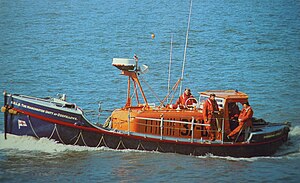Oakley-class lifeboat

RNLB Manchester Unity of Oddfellows (ON 960)
|
|
| Class overview | |
|---|---|
| Builders: |
|
| Operators: | Royal National Lifeboat Institution |
| Preceded by: | Liverpool/Watson |
| Succeeded by: | Rother/Solent |
| Cost: |
|
| Built: | 1958–1971 |
| In service: | 1958–1993 |
| Completed: |
|
| Retired: | 31 |
| Preserved: | 10 |
| General characteristics 37ft | |
| Displacement: | 12 long tons (12 t) |
| Length: | 37 ft (11 m) |
| Beam: | 11 ft 6 in (3.51 m) |
| Draught: | 3 ft 4 in (1.02 m) |
| Propulsion: | 2 × 43hp Perkins P4M/52hp Ford Thorneycroft/Parsons Porbeagle |
| Speed: | 8 knots (9.2 mph) |
| Complement: | 7 |
| General characteristics 48ft 6in | |
| Displacement: | 30 long tons (30 t) |
| Length: | 48 ft 6 in (14.78 m) |
| Beam: | 14 ft 0 in (4.27 m) |
| Draught: | 4 ft 4 in (1.32 m) |
| Propulsion: | 2 × 110bhp Gardner 6LX |
| Speed: | 8 knots (9.2 mph) |
| Complement: | 8 |
The Oakley-class lifeboat refers to two types of self-righting lifeboat operated by the Royal National Lifeboat Institution around the coast of the United Kingdom and Ireland between 1958 and 1993. The 37-foot Oakley was designed for carriage launching, while the larger 48-foot 6-inch version was designed for slipway launching or to lie afloat. During their service they saved a combined total of 1,456 lives in 3,734 rescue launches.
The class is known by the name of its designer, RNLI naval architect Richard A. Oakley.
During the first half of the twentieth century the RNLI had equipped its lifeboat stations with motor lifeboats designed by G L Watson and, later, J R Barnett. Both these men had designed boats that were generally stable, but unlike the earlier Peake-class boats, were not self-righting. Part of the problem was that motor lifeboats were much heavier than pulling and sailing boats, which could be packed with cork to make them buoyant. Richard Oakley worked out how to use shifting water ballast to create a self-righting motor lifeboat.
Oakley's 37-foot (11 m) prototype was launched in 1958 and placed in service at Scarborough. Production boats started to be built in 1961 and in 1963 the prototype 48-foot-6-inch (14.78 m) boat was launched and sent to Yarmouth. The last Barnett-class was built in 1960 and the final Watson-class in 1963, after which Oakleys were the only all-weather lifeboats put into service for the next four years.
The Oakley was designed as a self-righting boat. The design combined great stability with the ability to self-right in the event of it capsizing. This was achieved by a system of shifting water ballast. The system worked by the lifeboat taking on one and half tons of sea water at launching in to a tank built into the base of the hull. If the lifeboat then reached a crucial point of capsize the ballast water would transfer through valves to a righting tank built into the port side. If the capsize was to the starboard side of the lifeboat, the water shift started when an angle of 165° was reached. This would push the boat into completing a full 360° roll. If the capsize was to the port side, the water transfer started at 110°. In this case the weight of water combined with the weight of machinery aboard the lifeboat usually managed to stop the roll and allow the lifeboat to bounce back to upright. The water was discharged from the tank when the ship was taken out of the sea after each launch. A problem emerged with damp sand left in the tank after the water was drained. This caused a weak electrolytic action that eroded the copper nails which held the wooden hulls together.
...
Wikipedia
